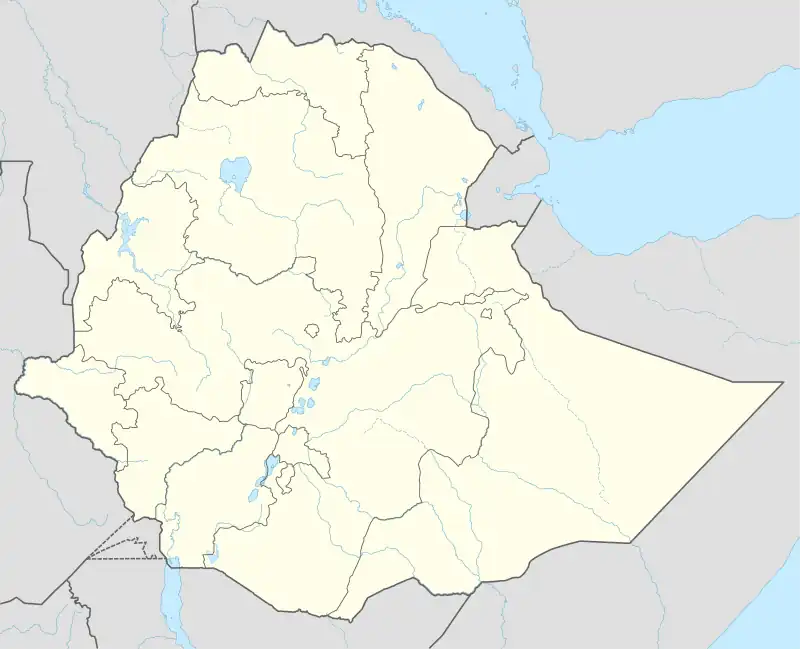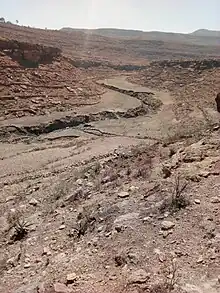Addi Walka | |
|---|---|
 | |
 Addi Walka Location within Ethiopia | |
| Coordinates: 13°43′N 39°18′E / 13.717°N 39.300°E | |
| Country | Ethiopia |
| Region | Tigray |
| Zone | Debub Misraqawi (Southeastern) |
| Woreda | Dogu'a Tembien |
| Area | |
| • Total | 66.61 km2 (25.72 sq mi) |
| Elevation | 2,400 m (7,900 ft) |
| Time zone | UTC+3 (EAT) |
Addi Walka is a tabia or municipality in the Dogu'a Tembien district of the Tigray Region of Ethiopia. The tabia centre is in Kelkele village, located approximately 16 km northeast of the woreda town Hagere Selam.
Geography
The tabia stretches down from Dogu'a Tembien's northern ridges towards the Agefet valley. The highest place is the cliff under Arebay (2,500 m.a.s.l.) and the lowest place along Agefet River (1,728 m.a.s.l.).


Geology
From the higher to the lower locations, the following geological formations are present:[1]
- Amba Aradam Formation
- Agula Shale[2]
- Antalo Limestone
- Adigrat Sandstone
- Edaga Arbi Glacials
- Quaternary alluvium and freshwater tufa[3]
Climate
The rainfall pattern shows a very high seasonality with 70 to 80% of the annual rain falling in July and August. Mean temperature in Kelkele is 18.8 °C, oscillating between average daily minimum of 10.5 °C and maximum of 26.7 °C. The contrasts between day and night air temperatures are much larger than seasonal contrasts.[4]
Springs
As there are no permanent rivers, the presence of springs is of utmost importance for the local people. The main springs in the tabia are:[5]
- May Deqisa'iri in Bet Moka'i
- Springs along Agefet River
Reservoirs
In this area with rains that last only for a couple of months per year, reservoirs of different sizes allow harvesting runoff from the rainy season for further use in the dry season. Traditional surface water harvesting ponds, particularly in places without permanent springs, are called rahaya. Horoyo, household ponds, have been recently constructed through campaigns.[6]
Settlements
The tabia centre Kelkele holds a few administrative offices, a health post, a primary school, and some small shops. There are a few more primary schools across the tabia. The main other populated places are:[7]
- Bet Moka'e
- Kidmi Tseged
- Ch'iwa
- Halah Gheralta
- Ziban Kebkeb
- Hatemti
- Hazgi
Agriculture and livelihood
The population lives essentially from crop farming, supplemented with off-season work in nearby towns. The land is dominated by farmlands which are clearly demarcated and are cropped every year. Hence the agricultural system is a permanent upland farming system.[8] The farmers have adapted their cropping systems to the spatio-temporal variability in rainfall.[9]
History and culture
History
The history of the tabia is strongly confounded with the history of Tembien.
Religion and churches
Most inhabitants are Orthodox Christians. The following churches are located in the tabia:
- Medhane Alem
- Hatemti Maryam
- Inda Gabir Amblo
- Abune Ego'id
- Bet Moka'e Mika'el
- Abune Ayezgi
- Abune Aregawi
- Kidane Mihret
- Bet Moka'e Mika'el
Inda Siwa
In the main villages, there are traditional beer houses (Inda Siwa), often in unique settings, which are a good place for resting and chatting with the local people. Most renown in the tabia is Tkun Asgedom at Bet Moka'e.[5]
Roads and communication
The main road Mekelle – Hagere Selam – Abiy Addi runs some 7–12 km south of the tabia. People have the choice to walk to Ala'isa or Tsigereda to find bus services to the towns. A rural access road (sometimes disused) links Addi Walka to the main asphalt road.

Tourism
Its mountainous nature and proximity to Mekelle makes the tabia fit for tourism.[10]
Geotouristic sites
The high variability of geological formations and the rugged topography invites for geological and geographic tourism or "geotourism".[11] Geosites in the tabia include especially the dissected, Grand Canyon-like landscapes.
Trekking routes
A trekking route has been established in this tabia.[12] The track of Gh1, from south to north across the tabia, is not marked on the ground but can be followed using downloaded .GPX files.[13]
Accommodation and facilities
The facilities are very basic.[14] One may be invited to spend the night in a rural homestead or ask permission to pitch a tent. Hotels are available in Hagere Selam and Mekelle.
References
- ↑ Sembroni, A.; Molin, P.; Dramis, F. (2019). Regional geology of the Dogu'a Tembien massif. In: Geo-trekking in Ethiopia's Tropical Mountains - The Dogu'a Tembien District. SpringerNature. ISBN 978-3-030-04954-6.
- ↑ Bosellini, A.; Russo, A.; Fantozzi, P.; Assefa, G.; Tadesse, S. (1997). "The Mesozoic succession of the Mekelle Outlier (Tigrai Province, Ethiopia)". Mem. Sci. Geol. 49: 95–116.
- ↑ Moeyersons, J. and colleagues (2006). "Age and backfill/overfill stratigraphy of two tufa dams, Tigray Highlands, Ethiopia: Evidence for Late Pleistocene and Holocene wet conditions". Palaeogeography, Palaeoclimatology, Palaeoecology. 230 (1–2): 162–178. Bibcode:2006PPP...230..165M. doi:10.1016/j.palaeo.2005.07.013.
- ↑ Jacob, M. and colleagues (2019). "Dogu'a Tembien's Tropical Mountain Climate". Geo-trekking in Ethiopia's Tropical Mountains. GeoGuide. SpringerNature. pp. 45–61. doi:10.1007/978-3-030-04955-3_3. ISBN 978-3-030-04954-6. S2CID 199105560.
- 1 2 What do we hear from the farmers in Dogu'a Tembien? [in Tigrinya]. Hagere Selam, Ethiopia. 2016. p. 100.
{{cite book}}: CS1 maint: location missing publisher (link) - ↑ Developers and farmers intertwining interventions: the case of rainwater harvesting and food-for-work in Degua Temben, Tigray, Ethiopia
- ↑ Jacob, M. and colleagues (2019). Geo-trekking map of Dogu'a Tembien (1:50,000). In: Geo-trekking in Ethiopia's Tropical Mountains - The Dogu'a Tembien District. SpringerNature. ISBN 978-3-030-04954-6.
- ↑ Nyssen, J.; Naudts, J.; De Geyndt, K.; Haile, Mitiku; Poesen, J.; Moeyersons, J.; Deckers, J. (2008). "Soils and land use in the Tigray highlands (Northern Ethiopia)". Land Degradation and Development. 19 (3): 257–274. doi:10.1002/ldr.840. S2CID 128492271.
- ↑ Frankl, A. and colleagues (2013). "The effect of rainfall on spatio‐temporal variability in cropping systems and duration of crop cover in the Northern Ethiopian Highlands". Soil Use and Management. 29 (3): 374–383. doi:10.1111/sum.12041. hdl:1854/LU-3123393. S2CID 95207289.
- ↑ Geo-trekking in Ethiopia's Tropical Mountains - The Dogu'a Tembien District. SpringerNature. 2019. ISBN 978-3-030-04954-6.
- ↑ Miruts Hagos and colleagues (2019). "Geosites, Geoheritage, Human-Environment Interactions, and Sustainable Geotourism in Dogu'a Tembien". Geo-trekking in Ethiopia's Tropical Mountains. GeoGuide. SpringerNature. pp. 3–27. doi:10.1007/978-3-030-04955-3_1. ISBN 978-3-030-04954-6. S2CID 199095921.
- ↑ Nyssen, Jan (2019). "Description of Trekking Routes in Dogu'a Tembien". Geo-trekking in Ethiopia's Tropical Mountains. GeoGuide. Springer-Nature. pp. 557–675. doi:10.1007/978-3-030-04955-3_38. ISBN 978-3-030-04954-6. S2CID 199271514.
- ↑ "Public GPS Traces tagged with nyssen-jacob-frankl".
- ↑ Nyssen, Jan (2019). "Logistics for the Trekker in a Rural Mountain District of Northern Ethiopia". Geo-trekking in Ethiopia's Tropical Mountains. GeoGuide. Springer-Nature. pp. 537–556. doi:10.1007/978-3-030-04955-3_37. ISBN 978-3-030-04954-6. S2CID 199198251.